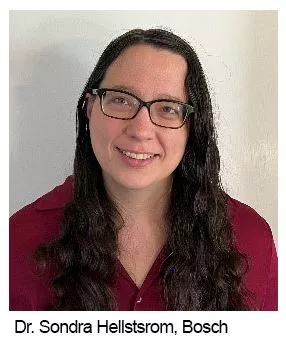
Throughout her career, Dr. Sondra Hellstrom, a principal engineer at Bosch, has developed game-changing technologies that make possible a healthier decarbonized world. She sat down with Tim Brosnihan, executive director of SEMI MEMS & Sensors Industry Group (MSIG), to discuss her decarbonization work and preview her presentation – New Paradigms in Smart Environmental Sensing – at MEMS & Sensors Technical Congress (MSTC), May 23-24 at MIT in Cambridge, Massachusetts. Registration for the event is open.
Brosnihan: When it comes to risks to human health, which is a bigger concern – particulate matter or volatile organic compounds (VOCs)?
Hellstrom: They are different. VOCs are gases. Particles are solid and liquid suspended droplets. VOCs are common components of fragrances, coffee or flowers. Many are not harmful, but some, like formaldehyde can be. The harm in VOCs is chemistry dependent.
Particles, on the other hand, especially at about 2 1/2 microns in diameter or less, can be suspended in air. Breathing a lot of particles of these sizes over time can contribute to some major health issues as they are inhaled deeply and can cause inflammation and other problems.
Detecting particles, as well as measuring and analyzing specific VOC combinations with new AI tools, is the focus of the Bosch sensor product line I will be addressing at MSTC.
Brosnihan: Do you foresee air quality monitors in every city, building, phone?
 Hellstrom: The potential for environmental sensors is very large. A growing body of findings on the effects of exposure to environmental pollution is raising awareness and many cities are deploying new ways to measure it and use that data to improve air quality. What’s more, many cities and private organizations are creating maps of local air quality based on various monitoring schemes.
Hellstrom: The potential for environmental sensors is very large. A growing body of findings on the effects of exposure to environmental pollution is raising awareness and many cities are deploying new ways to measure it and use that data to improve air quality. What’s more, many cities and private organizations are creating maps of local air quality based on various monitoring schemes.
One limitation of that approach is that particulate matter pollution is hyperlocal. If you are around a lit cigarette or an idling truck, the particulate count you can be exposed to can vary widely depending on your distance from the source as measured in feet. Sensors in public networks don't usually have the spatial resolution to give you accurate information about what you've been exposed to.
Air quality is also frequently worse indoors than outdoors. Indoor air pollution can be massive, especially in your kitchen. For example, cooking is a big emitter of particulate matter. Air quality monitors also need to be inside buildings and homes.
You can't control what you can't measure, and the usefulness of sensor data lies in where you can take action on the basis of the data. Demand-wise, air quality awareness varies from person to person, from region to region, and from situation to situation. It behooves us to do awareness building to grow the market.
Brosnihan: You have researched more efficient batteries and water purification systems using technology to help clean up the environment. What's your next move?
Hellstrom: Bosch builds unique sensor products that provide data to solve problems and meet needs, including those related to improving environmental stewardship or energy efficiency.
 For example, using smart thermostats or cooking hoods equipped with environmental sensors might help you ventilate the building in a more targeted way, and considerably improve that building’s energy efficiency. Air quality sensors might be used to collect data pertinent to wildfire management as they are huge CO2 emitters. Another example is using smart sensors to create community-based outdoor air quality maps as one way to enrich conversations and data around environmental justice.
For example, using smart thermostats or cooking hoods equipped with environmental sensors might help you ventilate the building in a more targeted way, and considerably improve that building’s energy efficiency. Air quality sensors might be used to collect data pertinent to wildfire management as they are huge CO2 emitters. Another example is using smart sensors to create community-based outdoor air quality maps as one way to enrich conversations and data around environmental justice.
We need to integrate more sustainability and environmental stewardship into big swaths of human behavior, or eventually we will exhaust our finite resources. Sensors can help us measure, analyze and abate particulate matter. I personally get very excited about this class of use cases. If you are working on one and attending MSTC, let's connect.
At Bosch Sensortec, we are looking to reach out to integrators who share our vision of building out solutions and developing ecosystems. Ecosystems for environmental sensors are complex and include technology development, reference designs such as the Arduino Nicla Sense ME, which incorporates our VOC sensor), use case discussions, and even sensing standards. We are interested in connecting across the ecosystem to implement solutions to outstanding challenges.
Brosnihan: What’s your call on the efficacy of a password vs. secret handshake?
Hellstrom: I will choose password, for its versatility. Secret handshakes only work in person of course, and only if no one is watching you, they take more time to execute and I suspect there is a smaller number of distinguishable permutations and combinations. Of course passwords are not good if you have to utter them. Also, living in the age of increasing machine interactions, no bank or car can accept a secret handshake.
Although, the secret handshakes perhaps create a stronger sense of connection between people, in a password world it is important to cultivate these kinds of connections in other ways.
About Dr. Sondra Hellstrom
Dr. Sondra Hellstrom manages business development and partner engagement at Bosch Sensortec with a focus on emerging products and innovation projects in optics and optical MEMS, including for environmental monitoring. She previously served in various engineering, scouting and analysis, and technical management capacities at Bosch Corporate Research, developing precommercial battery and hydrogen fuel cell technology, as well as water purification and carbon management solutions. She received her MPhil in Chemistry from Imperial College London and her Ph.D. in Applied Physics from Stanford University.
Heidi Hoffman is senior director of Corporate Marketing at SEMI.